Abstract
This study aims to improve the accuracy of small-scale landslide susceptibility maps (LSMs) by comparing two critical terrain factors—slope and relief energy. Slope is commonly used in LSMs, but its values are significantly sensitive to the spatial resolution of digital elevation models (DEMs). Although some studies have also addressed the effect of DEM resolution on relief parameters, direct comparisons between slope and relief energy remain limited. This research examines how these factors perform at different DEM resolutions and compare them to identify the most effective predictor for small-scale LSMs. Using the frequency ratio method, two LSM scenarios were evaluated: one using slope alongside geological units, and another using relief energy instead of slope, with various neighborhood distances. The study was conducted over a 29,785 km2 area in the Pannonian part of Croatia. The findings indicate that relief energy is more stable across different DEM resolutions and enhances the accuracy of LSMs, particularly in large and geologically diverse regions. These results suggest that relief energy may serve as a more reliable factor for small-scale LSMs, offering practical implications for improving landslide risk prediction and land management strategies.
1. Introduction
In the context of changing climate patterns and the increasing frequency of extreme meteorological events, the proactive management of natural hazards has become urgent. Regarding these hazards, the rise in heavy rainfall events has particularly led to more frequent landslides [1,2], posing a serious threat to human lives, infrastructure, and the environment [3,4,5]. Landslide susceptibility maps (LSMs) are key tools in mitigating such risks, estimating the spatial probability of landslide occurrence and serving as a foundation for hazard and risk assessment [6,7]. LSMs rely on determining conditioning factors (such as geological, geomorphological, and hydrogeological) that are similar to those under which landslides have previously occurred. Methods for generating LSMs primarily differ in how these factors are weighted, ranging from heuristic, expert-based approaches to quantitative models based on statistical and machine-learning techniques that reduce subjectivity [8,9,10].
Small-scale LSMs (scales smaller than 1:100,000 and areas larger than 10,000 km2) are especially important for national-level policy and planning, allowing the identification of the most vulnerable regions and the prioritization of detailed studies and resources [7,11]. However, producing such maps still presents challenges, due to the large spatial extent and the resulting low spatial resolution of available data, including digital elevation models (DEMs) and geological maps. Given the well-established correlation between landslide occurrence and geological settings, geology is a widely used and accepted factor in LSMs. Furthermore, the conditions that could lead a certain geological unit to a marginally stable state are frequently represented by slope.
However, slope values are highly sensitive to DEM resolution, which tend to decrease as the DEM is resampled to a coarser resolution [12,13,14]. In contrast, relief energy, defined as the difference between the highest and lowest elevation within a specific area [15], reflects broader topographic characteristics and may be better suited for small-scale analyses. Additionally, some studies indicate that relief energy remains relatively stable across different DEM resolutions, being more affected by the size of the neighborhood distance (ND) used in its calculation [16].
This study focuses on these two factors, slope and relief energy, addressing their direct comparison under varying DEM resolutions and assessing their impact on LSM accuracy. The objective is to evaluate whether relief energy can serve as a more stable and effective alternative to slope in the context of small-scale LSMs. To achieve this, two predictive models are constructed and compared: one using slope and the other using relief energy, both combined with geological units. Other conditioning factors are intentionally excluded, allowing for a clearer understanding of geomorphological contributions. This approach has the potential to improve the precision and reliability of national-scale LSMs and lays the groundwork for future studies incorporating additional conditioning factors and more complex methodologies.
2. Study Area
The study area covers the entire northern and eastern continental part of Croatia, spanning 29,785 km2, or approximately 50% of Croatian territory (Figure 1). This region forms part of the southwestern Pannonian Basin System [17], where geological settings greatly contribute to landslide susceptibility, particularly in areas with unfavorable geomorphological characteristics. Given that slides and flows occurring in soils are the predominant types of landslides in this region, the term “landslide” in this study refers exclusively to these types. The area is predominantly composed of plains, shaped mainly by the river systems of the Sava, Drava, and Danube. Roughly 78% of this region lies below 200 m in elevation. The landscape alternates between lowland plains and hilly or low mountainous terrain. Among these, Bilogora Mt. is the lowest, reaching an altitude of 309 m, while the highest peaks are on Medvednica, Ivanščica, and Žumberačka Gora mountains, exceeding 1000 m.
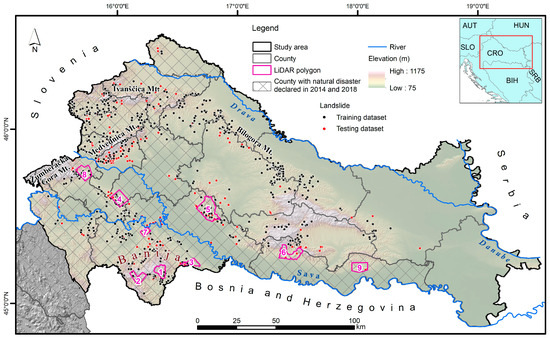
Figure 1.
Study area with landslide inventory (training and testing landslide dataset) and nine polygons where LiDAR scanning was performed (LiDAR polygons numbered 1–9).
This part of Croatia is composed of numerous geological units, ranging from Precambrian rocks to Quaternary deposits. While the youngest deposits, varying from marls and carbonate rocks to various clastic sediments, are predominantly exposed on the surface, Precambrian and Early Palaeozoic rocks are locally exposed on the slopes or cores of the hills and lower mountains [18,19].
According to a simplified climate regionalization, the study area belongs to the Cfb climate type in the Köppen classification, which represents a temperate warm humid climate with warm summers [20]. As reported in the Climate Atlas of Croatia [21], this region exhibits the characteristics of a continental climate, showing a clear trend of rising temperatures from west to east and increasing precipitation from east to west.
Based on a 30-year measurement period (1971–2000) and the data from seven meteorological stations distributed across the study area [21], the average mean annual air temperature is 10.5 °C. Mean monthly temperatures rise until June/July, reaching a maximum average of 20.6 °C. The average annual precipitation amount is 795.9 mm. Regarding the annual course of monthly precipitation amount, the main maximum occurs in June/July with an average of 91.3 mm, and the main minimum in January/February with an average of 40.4 mm. However, certain years show significant deviations in monthly precipitation compared to the average. Such deviations are key factors in triggering landslides. Recently, extreme precipitation events were recorded in the study area, particularly in 2014 and 2018, when floods and numerous landslides were reported. During these periods, a state of natural disaster was declared in seven counties (Figure 1).
In general, according to [22], the regions in the study area most affected by landslide processes are predominantly associated with the pediments and hills of the Peripannonian regions, which have been shaped by slope and fluvial-denudational processes on various types of Tertiary and Quaternary clastic sediments, as well as Eocene flysch. These processes are also present, though to a lesser extent, in the intermountain basins and river valleys of the Inner Dinarides in Banija, as well as in the loess bluffs of the Danube region in the easternmost part of the study area.
3. Materials and Methods
The main focus of this study is illustrated in Figure 2 and includes (a) testing the influence of DEM resolution on slope and relief energy, and (b) evaluating the performance of slope (scenario-1) versus relief energy (scenario-2) to support better LSM predictive results.
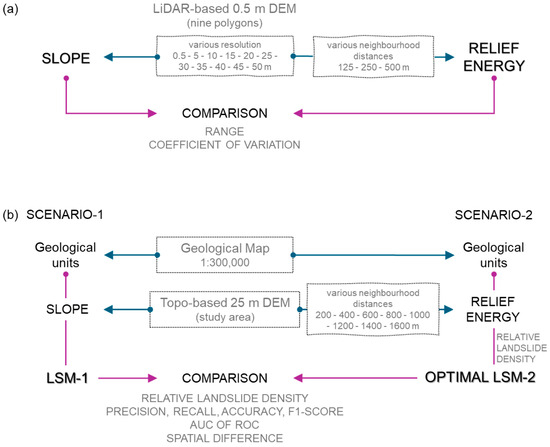
Figure 2.
Methodological scheme: (a) Assessing the influence of DEM resolution on slope and relief energy; (b) Evaluating the prediction performance of small-scale landslide susceptibility maps (LSMs), based on scenario-1 vs. scenario-2.
To test the influence of the DEM resolution on slope and relief energy (Figure 2a), a high-resolution DEM was required. Since such data were not available for the entire Croatian territory at the time of this study, nine available DEM polygons derived from LiDAR data (LiDAR-based DEM) were used. LiDAR scanning was conducted in 2018 and 2020, meeting the requirements of a minimum of 20 points per square meter and ensuring a positional accuracy within 10 cm in all directions. The final product of the post-processing of raw LiDAR data was a digital terrain model with a spatial resolution of 0.5 m. These LiDAR polygons cover approximately 512 km2 and are distributed across various geological units and topographic settings within the study area (Table 1). The original 0.5 m resolution LiDAR-based DEM was resampled to coarser resolutions from 0.5 to 50 m in 5 m increments. For each resolution, slope and relief energy were calculated, and their range and coefficient of variation (CV) were analyzed. Additionally, to assess the influence of ND on relief energy calculation, distances of 125, 250, and 500 m were tested.

Table 1.
Characteristics of LiDAR polygons used in this study.
In the second part of the analysis (Figure 2b), DEM based on the topographical map at a scale of 1:25,000 (topo-based DEM) was used. Covering the entire study area, this 25 m resolution DEM was applied as input to derive slope and relief energy for LSMs. Both slope and relief energy are reclassified into five classes using the natural break method. LSMs are derived using the frequency ratio (FR) method, considering geology and slope as conditioning factors in the first scenario (derivation of LSM-1), while utilizing geology and relief energy in the second scenario (derivation of LSM-2). Simultaneously various NDs for relief energy were tested. In this process, eight different LSM-2 models were derived, each using a distinct ND, ranging from 200 m to 1600 m in increments of 200 m. To determine the optimal LSM-2, the relative landslide density (RLD) is used. Finally, the comparison of LSM-1 and the optimal LSM-2 allows quantifying the effectiveness of relief energy in relation to slope. Several validation metrics are used, including RLD, a confusion matrix with related statistical indexes (precision, recall, accuracy, and F1-score), and the area under the curve (AUC) of the receiver operating characteristic (ROC). Additionally, the spatial difference between LSM-1 and the optimal LSM-2 is presented.
3.1. Slope and Relief Energy
Slope and relief energy are important conditioning factors that could render a certain geological unit unstable. These parameters can be easily derived from DEM using existing ready-to-use GIS tools. The term “slope” in the whole manuscript refers to the terrain slope angle.
The ArcGIS Slope tool calculates slope steepness for each cell by fitting a plane to the nine neighboring cells using a 3 × 3 moving window. This method does not allow for the manual definition of the ND; instead, it is automatically determined by the number of cells. Consequently, by increasing the cell size when changing resolution, the neighboring area increases.
Relief energy is calculated using the ArcGIS Focal Statistics tool with the Range Statistics option, which measures the difference between the maximum and minimum elevation values within a given area. This tool allows the ND to be manually specified, providing greater flexibility in adjusting the spatial scale of analysis independently from the DEM resolution.
3.2. Geological Units
Geology is one of the most important conditioning factors in landslide susceptibility assessment. It is typically represented by geological units, classified by a lithological approach (based on prevailing lithology) or a chronological approach (based on the age of deposition) [23]. Geological units are commonly derived from geological maps, which, for national-level LSMs, are commonly available at scales ranging from 1:200,000 up to 1:500,000 (e.g., [24,25,26,27]). In this study, geological units were extracted from the Geological Map of the Republic of Croatia at a scale of 1:300,000 [28]. At this scale, the map offers a comprehensive overview of the geology of large regional entities and the entire country, based on the chronostratigraphic classification and lithological description [18]. The geological development of the study area, description of the relevant units, and its material properties are described by [29].
The foundation of the study area is primarily built of igneous, clastic, and metamorphic rocks of the Precambrian, Palaeozoic, and Cenozoic age, and secondary of limestone and dolomite (Figure 3). This geological basis has shaped gentle relief and a well-developed surface water system [18]. The most abundant superficial geological units are Holocene alluvial deposits and Pleistocene terrigenous and marsh loess, which together cover over 50% of the study area. On the other hand, some geological units have very limited spatial extent, with 14 units covering areas smaller than 10 km2.
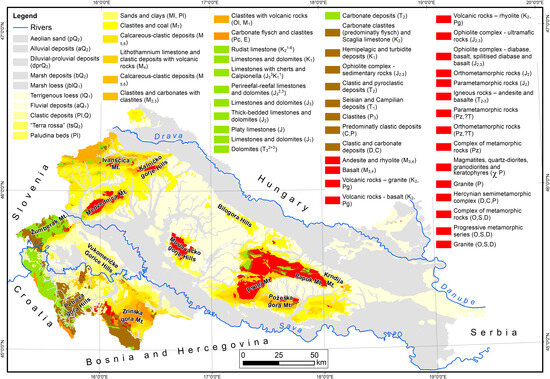
Figure 3.
Simplified geological map of the study area at a scale of 1:300,000 (according to [28]).
To integrate this geological data into the study, vector data was transformed into a raster with a resolution of 25 m, aligning with the resolution of the available topo-based DEM. Each of the 54 identified geological units is represented as a separate category, with no generalization applied.
3.3. Landslide Inventory
Landslide inventories play a crucial role in determining the accuracy of LSMs, as reliable data on landslide distribution is essential for effective modelling. In Croatia, there is still no systematic national-level assemblage of landslide data. Therefore, this study relies on four available landslide inventories, comprising a total of 1003 landslides (Table 2). Together, they represent an initial effort toward the systematic collection and digitization of landslide data in Croatia. The inventories are presented in detail by [30], including full descriptions of data sources, acquisition methods, and limitations.

Table 2.
Main data of landslide inventories used in this study.
Three of these inventories, derived from historical geological maps, are synthesized to form the training dataset for modelling LSMs. In addition, a landslide inventory from the publicly accessible web portal “Report a Landslide” is used as the testing dataset for validating the LSMs. Although the common practice is to randomly split inventory data into 70% for training and 30% for testing, the division used in this study seems logical, given that LSM aims to predict areas where landslides are likely to occur in the future. Accordingly, the training dataset includes landslides that were activated in the past, while the testing dataset comprises the majority of landslides that have recently been (re)activated.
3.4. Derivation of Landslide Susceptibility Maps: Frequency Ratio Method
To derive LSMs using the FR method, weights for all categories of conditioning factors are calculated based on a training landslide dataset comprising 765 landslide locations. The FR method, proposed by [34], is the most commonly used in landslide susceptibility assessment among the bivariate statistical methods [35,36]. The FR for each factor category is calculated as the ratio between the percentage of the landslide number in a certain factor class and the percentage of the area of that factor class (Equation (1)).
where nLi is the number of landslides within the factor class i, Ai is the area of a certain factor class i, nLT is the total number of landslides within the study area, and AT is the total study area.
In this study, FR values are normalized to their maximum value for each parameter (FRn) to obtain maximum values of 1. For further calculations, the ArcGIS Raster Calculator is used. Since it only supports integer values, FRn values are multiplied by 100 (FRn100) to facilitate the final preparation of factor maps for LSMs.
Given that the relationships among factors are not considered, the landslide susceptibility index (LSI) for each raster cell is calculated as the sum of FRn100 values for each factor category (Equation (2)).
The resulting LSMs are adjusted for small-scale presentation, based on the smallest resolution of the input data, which is the geological map at a scale of 1:300,000. According to this scale, and following the recommendations of [37], the LSMs are resampled to a resolution of 150 × 150 m. In order to present the landslide susceptibility in defined susceptibility zones, LSI values are reclassified using the Natural Breaks classification method, defining four susceptibility zones: low, moderate, high, and very high. This classification reduces subjectivity and enables the comparability between the derived LSM-1 and LSM-2 models.
3.5. Evaluation of Landslide Susceptibility Maps
The evaluation and comparison of LSMs are conducted using following methods (Figure 2):
- RLD measures the ratio of the percentage of landslides within each landslide susceptibility zone to the percentage of the area of that particular susceptibility zone [38].
- A confusion matrix is employed to evaluate the model’s performance by mapping its actual and predicted values. For binary outcomes (in our case landslide vs. non-landslide), the confusion matrix generates a two-dimensional table showing (a) true positives (TPs), pixels correctly predicted as landslides, (b) false positives (FPs), pixels predicted as landslides but are actually non-landslides, (c) true negatives (TNs), pixels correctly predicted as non-landslides and (d) false negative (FNs), pixels predicted as non-landslides but are actually landslides.From the confusion matrix, several statistical measures are derived [39]:
- The ROC curve is a graphical representation that illustrates the ability of a binary classifier to discriminate between positive and negative cases (landslides and non-landslides) as the discrimination threshold varies. It plots the true positive rate (TPR), also known as sensitivity or recall (Equation (4)), against the false positive rate (FPR), calculated as
- AUC of ROC provides a measure of the model’s discrimination ability and allows investigators to compare the performance of two or more diagnostic tests [40]. An AUC value of 0.5 indicates no discrimination, i.e., the model performs no better than random guessing. In that case, the ROC curve will fall on the diagonal line. ROC curves falling above this diagonal line suggest a reasonable ability to discriminate between positives and negatives. The AUC can be interpreted as follows [41]: (a) AUC = 0.5: no discrimination, (b) 0.7 ≤ AUC < 0.8: acceptable discrimination, (c) 0.8 ≤ AUC < 0.9: excellent discrimination, and (d) AUC ≥ 0.9: outstanding discrimination.
4. Results and Discussion
4.1. The Impact of DEM Resolution on Slope and Relief Energy
To enable a comparative analysis between slope and relief energy, the range and coefficient of variation (CV) are presented (Figure 4). These statistical measures show consistent trends as the DEM resolution decreases, regardless of the varying topographical and geological characteristics across the nine LiDAR polygons.
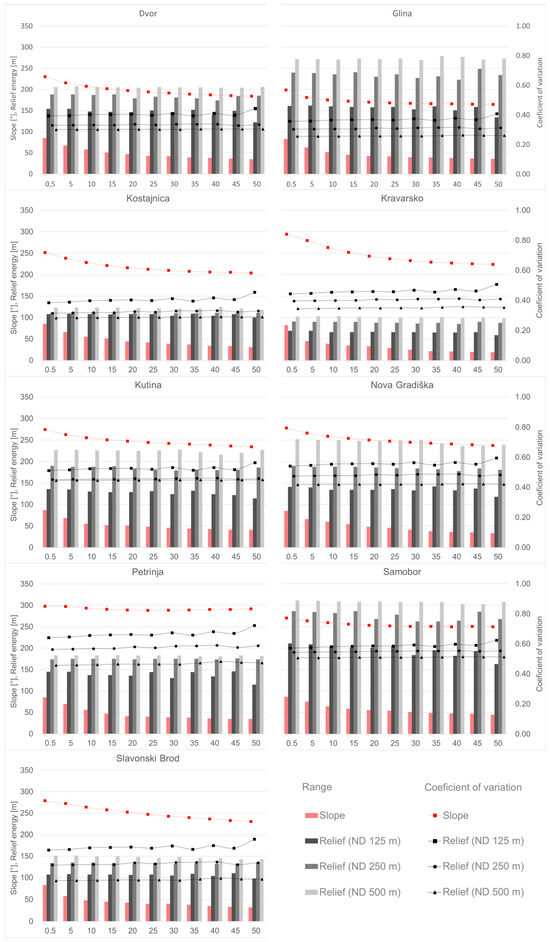
Figure 4.
Comparison of range and coefficient of variation (CV) of slope and relief energy within nine LiDAR polygons for different DEM resolution (x axis).
The range for slope decreases mainly due to the loss of the uppermost values, with a marked drop observed up to resolution of 20 m to 25 m. Beyond this point, the values stabilize, showing only a gradual decrease at coarser resolutions. In contrast, the range for relief energy remains mostly stable, with minor variations at higher resolutions and more pronounced changes only at 40 m and 50 m. These differences diminish as the ND value increases. For slope, CV values range from a minimum of 0.47 for the coarsest resolution (50 m) to a maximum of 0.85 for the highest resolution (0.5 m). The average value of 0.68 suggests high relative variability (CV > 0.5), with data points widely spread from the mean, indicating a significant level of variation. For relief energy, it is evident that the CV decreases as the ND increases. For relief energy with a ND of 125 m, the average CV value of 0.5 suggests high relative variability (CV > 0.5). For relief energy with an ND of 250 m, CV values are getting smaller, with the average CV value of 0.42, indicating a moderate level of data spread around the mean (0.2 < CV < 0.5). For relief energy with an ND of 500 m, CV values are getting even more smaller, with an average value of 0.37, indicating lower relative variability and suggesting more stability and consistency in the data. Due to the consistent pattern of decreasing CV values, the results suggest that, at very small ND values, the CV for relief energy would likely approach that slope. Similar findings were reported by [16], who noted that the ND must be large enough to include both valleys and interfluves in order to capture meaningful relief variation, rather than merely reflecting local slope. Overall, the analysis demonstrates that relief energy remains more stable than slope when DEM resolution decreases. Thus, it is reasonable to assume that relief energy will better represent the condition of geological units than slope when preparing small-scale LSMs.
To assess the accuracy of the 25 m topo-based DEM, the slope and relief energy derived from it were compared with those from a resampled 25 m LiDAR-based DEM (Figure 5). The comparison was performed across polygons where the LiDAR-based DEM was available. The results showed minimal differences between the two datasets, particularly in mean values. These findings indicate that the 25 m topo-based DEM is sufficiently accurate to represent the geomorphological features relevant for regional-scale susceptibility modelling. However, the results also highlight the importance of specifying the DEM source, as a resampled LiDAR-based DEM, despite having the same resolution, provides a more precise and detailed representation of terrain morphology. As demonstrated by [42], LiDAR enables high-density and accurate terrain capture, and its datasets can be reduced by up to 50% without significantly affecting DEM quality. This allows for more efficient storage and processing, while maintaining detailed and reliable topographic information.
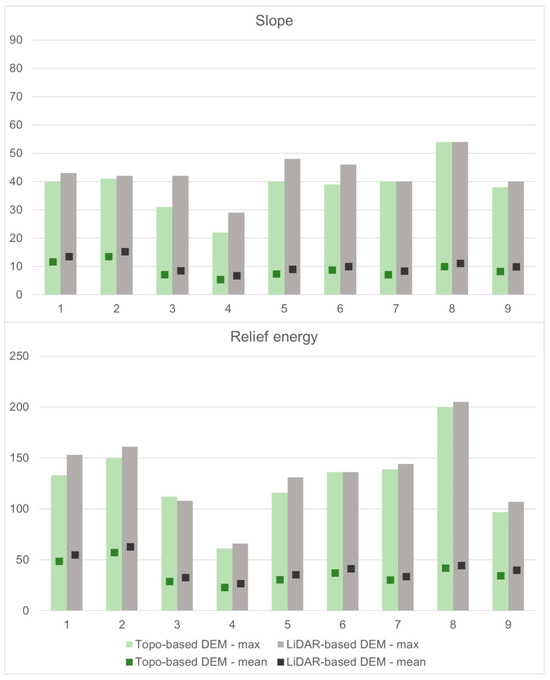
Figure 5.
Comparison of the maximum and mean values of slope and relief energy between resampled 25 m LiDAR-based DEM and 25 m topo-based DEM for nine LiDAR polygons.
4.2. Weights of Parameter Categories for LSM Derivation
Each category of conditioning factors was ranked according to its relationship with landslide occurrence. FR weights are calculated, normalized (FRn), and multiplied by 100 (FRn100). These FRn100 values are then assigned to each parameter category for further LSM calculation (Table 3).

Table 3.
Weights of the conditioning factor categories based on the frequency ratio method for (a) geology; (b) slope; and (c) relief energy. Note: The total number of landslides in the training dataset is 765 and the total area is 29,785.5 km2.
Since the FR method is based on the principle of conditional probability, its values can be interpreted as follows: the greater the ratio, the stronger the relationship between landslides and a particular factor category [38]. According to the normalized FRn values, which range between 0 and 1, the presented weights are interpreted in the following way (Table 3): if the value is greater than 0.75, the factor category has a strong influence on landslide occurrence; if the value is smaller than 0.25, the factor category has a minor influence. A weight values of zero are assigned to 28 geological units within which no landslides were recorded. These units cover together 24% of the study area (an average area of 0.86%) of which 26 units are each represented with an area of less than 0.6%.
Considering geology as a conditioning factor, the highest weights are calculated for the geological units of the Neogene age, specifically the Oligocene–Miocene to Pliocene, presented by clastic Paludina deposits (Pl), clastites and carbonates with clastites (M2,3), clastites with volcanic rocks (Ol,M1), and clastites and coal (M7). These units together cover an area of almost 12% (an average area of 3%). The total number of landslides from the training dataset within these four units is 377 (almost 50%), with 26% of landslides within geological unit M7. Besides those geological units for which the FRn value equals zero, the smallest FRn values are calculated for eleven geological units. They belong to different geological ages and are presented with different lithological characteristics. These units cover 48% of the study area, with an average area of 4.4% per unit. Together, they contain 141 landslides from the training dataset (i.e., 18%), with the proportion of landslides in individual units ranging from 0.13% to 13%.
Several previous studies conducted in the same region have also addressed the relationship between geological units and landslide susceptibility. The Energy Relief Index (ERI) is introduced to evaluate the landslide potential of geological units by [29], using the same geological map and landslide inventories as applied in this study. Their results showed that the units with the lowest ERI values, indicating the highest landslide potential, belong to a group of Paleogene and Neogene formations. These units are characterized by unstable equilibrium due to their location within accumulation–denudation morphotectonic zones dominated by exogenic processes. In particular, the Miocene units M7 and M5,6, along with the Paleocene–Eocene transitional unit (Pc,E), were identified as the most landslide-prone. Notably, all geological units identified in this study with the highest FRn values also fall within this same group. These findings are further supported by studies based on LiDAR-derived landslide inventories [43,44,45,46,47], which confirm the concentration of landslides within the same geological formations. Although a direct comparison is limited by differences in geological map scale (1:100,000) and inventory format (high-resolution, polygon-based landslide presentation), the consistency across studies reinforces the significance of these geological units in regional-scale susceptibility assessments.
When analyzing slope, the highest weights are assigned to slope categories two and three, ranging from 4° to 16°, within which nearly 70% of landslides from the training dataset are present. The FRn values decrease for higher slope categories, indicating that the steepest slopes are not the most susceptible to landslides. This is strongly influenced by the competency and weakness of the material, as discussed in the previous study [48]. FRn value is the smallest within slope category one, due to the large area that it covers (66% of the entire study area) and presumably the small number of landslides in low-angle terrain (0–3°). Unexpectantly, 22% of all landslides fall into this category. The cause for this large number of landslides is two-fold. Firstly, the slope data used in the analysis underestimates higher slope values, due to the low resolution of the input 25 m topo-based DEM. Secondly, the positional precision of the used landslide inventories is low, even compared to the 25 × 25 m resolution of slope data. This often results in the misplacement of landslide points into inappropriate slope values. Both problems are typical for small-scale studies and both can be remediated using relief energy instead.
In view of relief energy, categories two and three, within a range from 147 m to 215 m, show the strongest relationship to landslide occurrence. Within these two categories, 85% of the landslides from the training dataset are present. Similarly to the slope, from that point to the highest relief energy values, the weights slightly decrease. However, there is a strong decrease toward the lowest category range, where only seven landslides are present (<1% of landslides from the training dataset). Following the same methodology for calculating the FRn weight values, different relief energy models were tested by changing the NDs (Figure 6). The results show that the minimum weight value of 1 is assigned to category one, across all LSM-2 models. The maximum weight values of 100 are assigned to category three in all LSM models, except for the LSM-2 model with an ND of 1200 m, where the highest weight value is within category two. The largest difference in FRn values among LSM-2 models, a difference of 39, is observed in relief category five. These factor weights directly influence the calculation of LSMs and their subsequent validation identified the optimal LSM-2.
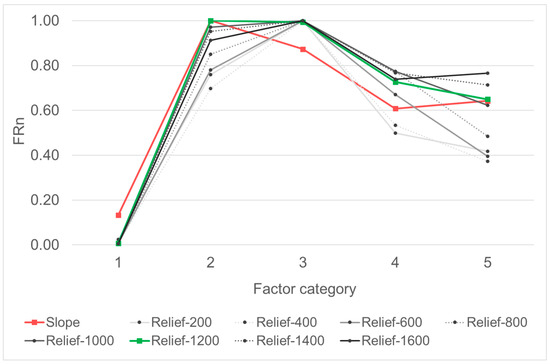
Figure 6.
Comparison of weight values of relief energy categories for various neighborhood distances. Weight values for slope categories are also presented for comparison.
The selection of ND values in the range of 200–1600 m was intended to capture a broad spectrum of topographic variation, from typical landslide lengths to full slope lengths, which are relevant for small-scale (regional) landslide susceptibility mapping. This range was chosen to analyze how the relief energy responds to progressively larger terrain contexts, helping to identify the scale at which this factor best distinguishes between geological units. The chosen values were informed by both local topographic reasoning and prior research. Several previous studies conducted in the same area [43,44,45,49] used NDs typically between 125 m and 500 m. These values were primarily determined based on local-scale analyses of average slope lengths and calculated using high-resolution (0.5 m) DEM. This served as the basis for defining the minimum ND used in this study. However, because the current research is conducted for small-scale analysis, a broader generalization of topographic features is necessary, justifying the use of a maximum ND of 1600 m based on regional topographic characteristics.
When calculating relief energy in various environments, it is highly recommended to perform calculations using several NDs first, as different topographic types require different thresholds. The representative ND must be carefully determined, as already confirmed by [16,50]. If the distance is too small, it will only represent the slope gradient, while if it is too large, the relief energy may overgeneralize the terrain and mask important topographic details, particularly in areas with complex morphology. For LSM derivation, the optimal ND should capture the entire slope length to accurately determine where landslides are more likely to occur.
4.3. Optimal LSM-2 Model
The optimal LSM-2 model was selected based on its consistent RLD pattern and landslide counts across susceptibility zones in both training and testing datasets. The results presented in Figure 7 show a clear rising trend of RLD towards higher susceptibility classes, reflecting strong performance in identifying landslide-prone areas. This trend is consistent across all LSM models for both the training and testing landslide datasets. However, for several models, there is a noticeably higher number of landslides in zone 2 compared to zone 3 in the testing dataset.
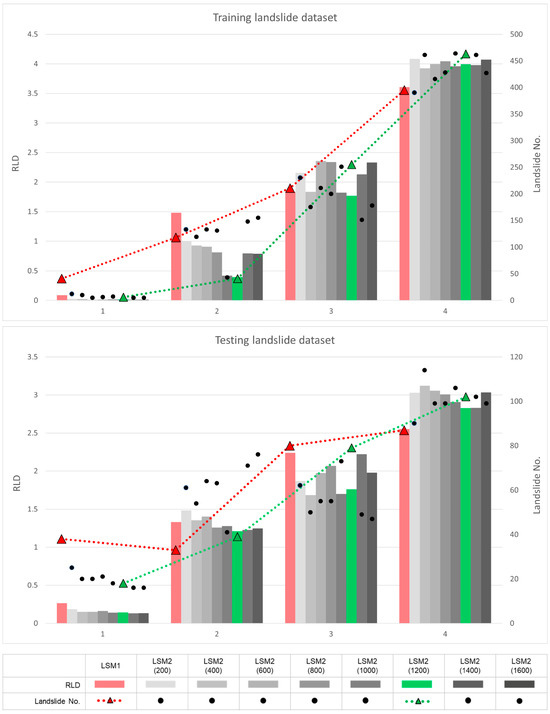
Figure 7.
Relative landslide density (RLD) and the number of landslides (Landslide No.) within each landslide susceptibility zone (1—low, 2—moderate, 3—high, 4—very high) of LSM-1 and various LSMs-2 for training landslide dataset and testing landslide dataset.
Using the relief energy derived with an ND of 1200 m, the model shows one of the highest RLD values in zone 4 and the lowest in zone 1, with minimal landslides detected there. In the training dataset, the landslide counts reach up to 255 in zone 3 and as low as 41 in zone 2. In the testing dataset, zone 3 has up to 79 landslides, while zone 2 has fewer landslides. Compared to other models, this configuration balances a high number of detected landslides in high-susceptibility zones with a low density in low-susceptibility zones, outperforming all LSM-2 models, including the most similar one with an ND of 1000 m. While smaller NDs offered more localized terrain representation, the 1200 m ND better captured the broader relief structure relevant to regional susceptibility assessment, improving both the accuracy and spatial consistency of the model.
4.4. Comparison of LSM-1 and the Optimal LSM-2
For both LSM-1 and the optimal LSM-2, the maximum calculated LSI value is 200, while the minimum values are 13 and 1, respectively. They are presented in Figure 8, where LSI values are reclassified into four susceptibility zones.
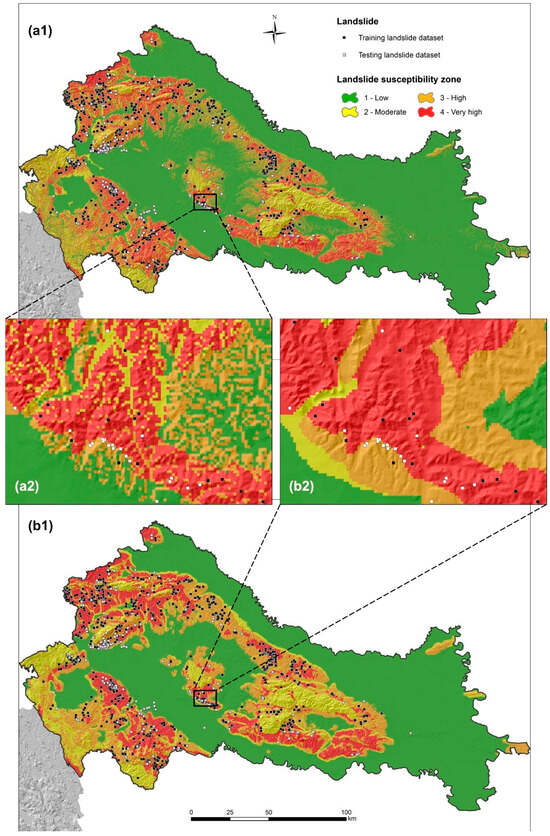
Figure 8.
Visual comparison of LSM-1 (a1) and the optimal LSM-2 (b1), with enlarged views shown in (a2,b2).
The visual interpretation of the spatial distribution of susceptibility zones shows a similar pattern in both LSMs, with high and very high susceptibility areas concentrated in common regions (Figure 8). However, in enlarged views shown in Figure 8 it is evident that the susceptibility zones in LSM-1 are represented by narrower areas and are significantly pixelated. They often transition abruptly from zone three to zone one or from zone four to zone two, and rarely directly from the highest susceptibility zone (4) to the lowest (1). On the other hand, susceptibility zones in the optimal LSM-2 are represented by slightly broader areas that attempt to more effectively generalize the data. Transitions between zones are much smoother and more continuous. These differences are a direct consequence of the methods used to calculate slope and relief energy, including a much larger ND (1200 m) used to derive relief energy for LSM-2.
The presented results confirm that, for small-scale mapping, where large areas are zoned and generalizations are recommended and justified, it is better to use relief energy instead of slope for creating LSM. For the validation of LSMs, especially when using point data from small-scale landslide inventories, LSM-2 is more reliable. In contrast, LSM-1, due to its pronounced pixelation and abrupt zone transitions, may result in landslides falling into specific susceptibility zones only by chance.
The LSM-1 and the optimal LSM-2 were additionally compared by RLD (Figure 7), statistical parameters of the confusion matrix (Table 4), ROC curves and AUC values (Figure 9), and the spatial distribution of differences between landslide susceptibility zones (Figure 10 and Table 5).

Table 4.
Confusion matrix and statistical indexes of LSM-1 and the optimal LSM-2 for ten samples. TPs—true positives, FNs—false negatives, FPs—false positives, TNs—true negatives.
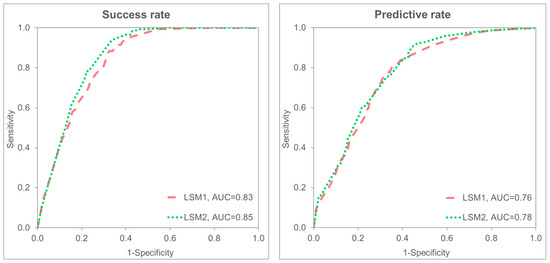
Figure 9.
ROC curve and AUC value calculated for LSM-1 and optimal LSM-2 using the training landslide dataset (Success rate) and the testing landslide dataset (Predictive rate).
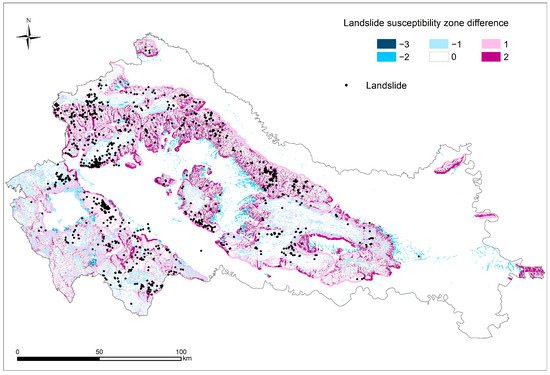
Figure 10.
Spatial distribution of landslide susceptibility class differences between LSM-1 and optimal LSM-2.

Table 5.
Area of landslide susceptibility zone differences between LSM-1 and optimal LSM-2 and number of landslides within each category.
The comparison of RLD and landslide counts across susceptibility zones shows that, regardless of ND, relief energy yields more effective and accurate predictions than slope (Figure 7). This is consistent across all zones for both training and testing datasets. While LSM-1 has a slightly higher RLD in zone 3 (training dataset) and significantly higher in zone 3 (testing dataset), the overall number of landslides and RLD values, particularly in zones 1 and 4, favor the optimal LSM-2 model based on relief energy.
Based on the confusion matrix of the LSM models, several statistical measures were calculated, including precision, recall, accuracy, and the F1-score (Table 4). In this context, predicted positives (landslides) refer to the LSMs raster cells that fall into very high (4) and high (3) susceptibility zones, while predicted negatives (non-landslides) are the raster cells in low (1) and moderate (2) susceptibility zones. The actual positives and negatives represent true landslide and non-landslide areas, respectively.
Since there is a class imbalance between the positive and negative cases, the confusion matrix was calculated for 10 samples where non-landslide areas were randomly selected to include an equal number of cells as the landslide areas [51], i.e., 991 raster cells. The number 991 differs from the 1003 landslide data points used in this study because some landslide points fall into the same raster cell. Finally, the average of the statistical indices across these 10 samples was calculated and compared (Table 4).
The average precision values are the same for both LSM-1 and the optimal LSM-2 (0.72), indicating that both models perform equally well in providing relevant positive predictions (landslides). Still, there are also some differences in statistical metrics between these two models, of which the largest difference is in the recall metric, with an average of 0.77 for LSM-1 and 0.90 for the optimal LSM-2. This suggests that LSM-2 is better at correctly identifying the actual landslide occurrences (positives). The overall prediction accuracy, which measures how well both positives and negatives are predicted, is slightly higher for the optimal LSM-2 compared to LSM-1, with average values of 0.78 and 0.74, respectively. Similarly, the F1-score, which balances the precision and recall, is also higher for the optimal LSM-2, with average values of 0.80 compared to 0.75 for LSM-1. This indicates that LSM-2 has a better overall prediction performance and more accurately reflects landslide susceptibility.
Although the visual comparison of LSMs shows significant differences, the ROC curves and AUC values are similar (Figure 9). According to the AUC success rate values of 0.83 and 0.85, the accuracy for both LSMs is excellent (0.8–0.9), and according to the AUC predictive rate values, it is acceptable (0.7–0.8).
Finally, the comparison between LSMs is presented through the analysis of the spatial distribution of differences in landslide susceptibility zones (Figure 10, Table 5), which are calculated by subtracting two rasters, the optimal LSM-2 and LSM-1. Thus, positive values indicate that the LSM-2 zones are higher than the LSM-1 zones, while negative values refer to the differences where the LSM-1 zones are higher than the LSM-2 zones.
From the results shown in Table 5, it can be seen that the largest portion of the study area, approximately 76%, has no difference in susceptibility zones (0-difference category). Of this, 67% corresponds to zones classified as low susceptibility and a significant portion of the area to zones of very high and high susceptibility, accounting for 14% and 11%, respectively, which is the cause of a large number of landslides (629) in this difference category.
The areas where the susceptibility zones between LSMs differ by one category are almost evenly distributed for −1- and 1-difference categories, with 7% and 8%, respectively, both showing a similar number of landslides. Notably, of particular interest is the area in the 2-difference category, which covers around 7% of the total area and contains nearly 13% of the landslides mapped. In this category, the susceptibility zones in the optimal LSM-2 are two levels higher than those in LSM-1, indicating that the slope underestimated landslide susceptibility compared to relief energy in these regions.
5. Conclusions
This study set out to evaluate the impact of DEM spatial resolution on the slope and relief energy parameters and assess the viability of integrating relief energy into small-scale LSMs. The findings demonstrated that relief energy is more stable than slope when DEM resolution decreases. By resampling a high-resolution LiDAR-based DEM to coarser resolutions, it became evident that relief energy values are less influenced by resolution changes, establishing it as a more reliable parameter for small-scale mapping.
Additionally, by utilizing a 25 m cell size topo-based DEM across the entire study area, a comparative analysis of slope and relief energy for LSM derivation was possible. The results indicated and verifications confirmed that relief energy, particularly with an optimal ND of 1200 m, improves the prediction accuracy of landslide-prone areas, and at the same time, enhances the identification of low susceptibility zones. This highlights the importance of selecting an appropriate ND that aligns with the size of the research area and its topographic characteristics. In contrast, the slope’s reliability was found to be more sensitive to DEM resolution, significantly affecting its predictive accuracy, especially for small-scale mapping. However, the study acknowledges some limitations, particularly those related to the spatial accuracy and completeness of the landslide inventory. Geographic biases, such as concentrated mapping in landslide-prone areas or the reporting of landslide events only when they pose a direct threat to people, influenced the dataset. Still, the landslide inventory used is deemed representative of small-scale susceptibility mapping, although improvements in coverage and detail are recommended for future studies.
This research contributes to the broader field of geohazard assessment. The demonstrated stability of relief energy across varying resolutions, together with LSM predictive performance, makes it a strong candidate for integration into susceptibility and hazard mapping. The findings are particularly relevant for countries or regions where high-resolution DEM data may not be available consistently, offering a reliable alternative to slope-based models.
Future investigations should prioritize the development of a comprehensive and standardized landslide inventory that encompasses entire macro-regions or even the entire country, covering all geological units and topographic features in a balanced manner. The field validation of landslide susceptibility maps is also highly encouraged to increase reliability. With the recent nationwide completion of LiDAR scanning in Croatia and the availability of derived 1 m resolution LiDAR-based DEM since 2024, there is now a strong foundation for advancing landslide modeling across the country. This primarily refers to the development of a detailed landslide inventory for the Pannonian region of Croatia that should continue and expand. This advancement, combining the insights from this research, and integrating other geomorphological and environmental conditioning factors as well as more advanced machine learning approaches, is expected to enhance the precision of future landslide susceptibility and risk assessments.
Author Contributions
Conceptualization, I.B., V.G., D.P. and T.F.; Formal Analysis, I.B.; Methodology, I.B. and V.G.; Validation, I.B.; Visualization, I.B. and T.F.; Writing—Original Draft, I.B.; Writing—Review and Editing, V.G., D.P. and T.F. All authors have read and agreed to the published version of the manuscript.
Funding
LiDAR data used in this study were acquired through the safEarth (No. HR-BA-ME59) and RESPONSa (No. HR-BA-ME367) projects, implemented under the Interreg IPA Cross-border Cooperation Program Croatia-Bosnia and Herzegovina-Montenegro 2014–2020. Open access is supported by the GeoTwinn project (ID 809943), implemented under the Call H2020-WIDESPREAD-05-2017-Twinning.
Data Availability Statement
The original contributions presented in this study are included in the article. Further inquiries can be directed to the corresponding author.
Acknowledgments
The authors would like to express their gratitude to the following colleagues from the Croatian Geological Survey: Josip Kolarić and Ivan Markotić for their efforts in digitizing landslides from available geological maps; Marina Filipović and Mirja Pavić for their work in establishing the “Report a Landslide” web portal; and Mario Dolić for his significant efforts in coordinating all these activities. Special thanks are extended to Martina Michalikova for her valuable insights and suggestions on effective writing, shared during the “Write Up Your Paper, 2024” course, when the first draft of this paper was developed.
Conflicts of Interest
The authors declare no conflicts of interest.
References
- Crozier, M.J. Deciphering the Effect of Climate Change on Landslide Activity: A Review. Geomorphology 2010, 124, 260–267. [Google Scholar] [CrossRef]
- Jemec Auflič, M.; Bezak, N.; Šegina, E.; Frantar, P.; Gariano, S.L.; Medved, A.; Peternel, T. Climate Change Increases the Number of Landslides at the Juncture of the Alpine, Pannonian and Mediterranean Regions. Sci. Rep. 2023, 13, 23085. [Google Scholar] [CrossRef] [PubMed]
- Haque, U.; Blum, P.; da Silva, P.F.; Andersen, P.; Pilz, J.; Chalov, S.R.; Malet, J.P.; Auflič, M.J.; Andres, N.; Poyiadji, E.; et al. Fatal Landslides in Europe. Landslides 2016, 13, 1545–1554. [Google Scholar] [CrossRef]
- Sim, K.B.; Lee, M.L.; Wong, S.Y. A Review of Landslide Acceptable Risk and Tolerable Risk. Geoenviron. Disasters 2022, 9, 3. [Google Scholar] [CrossRef]
- Petrucci, O. Landslide Fatality Occurrence: A Systematic Review of Research Published between January 2010 and March 2022. Sustainability 2022, 14, 9346. [Google Scholar] [CrossRef]
- Chacón, J.; Irigaray, C.; Fernández, T.; El Hamdouni, R. Engineering Geology Maps: Landslides and Geographical Information Systems. Bull. Eng. Geol. Environ. 2006, 65, 341–411. [Google Scholar] [CrossRef]
- Fell, R.; Corominas, J.; Bonnard, C.; Cascini, L.; Leroi, E.; Savage, W.Z. Guidelines for Landslide Susceptibility, Hazard and Risk Zoning for Land Use Planning. Eng. Geol. 2008, 102, 85–98. [Google Scholar] [CrossRef]
- Corominas, J.; van Westen, C.; Frattini, P.; Cascini, L.; Malet, J.P.; Fotopoulou, S.; Catani, F.; Van Den Eeckhaut, M.; Mavrouli, O.; Agliardi, F.; et al. Recommendations for the Quantitative Analysis of Landslide Risk. Bull. Eng. Geol. Environ. 2014, 73, 209–263. [Google Scholar] [CrossRef]
- Hervás, J.; Bobrowsky, P. Mapping: Inventories, Susceptibility, Hazard and Risk. In Landslides-Disaster Risk Reduction; Sassa, K., Canuti, P., Eds.; Springer: Berlin/Heidelberg, Germany, 2009; pp. 321–348. ISBN 9783540699705. [Google Scholar]
- Manan, W.A.A.; Rashid, A.S.A.; Abdul Rahman, M.Z.A.; Khanan, M.F.A. Assessment on Recent Landslide Susceptibility Mapping Methods: A Review. IOP Conf. Ser. Earth Environ. Sci. 2022, 971, 012032. [Google Scholar] [CrossRef]
- Cascini, L. Applicability of Landslide Susceptibility and Hazard Zoning at Different Scales. Eng. Geol. 2008, 102, 164–177. [Google Scholar] [CrossRef]
- Grohman, C.H. Effects of Spatial Resolution on Slope and Aspect Derivation for Regional-Scale Analysis. Comput. Geosci. 2015, 77, 111–117. [Google Scholar] [CrossRef]
- Vaze, J.; Teng, J.; Spencer, G. Impact of DEM Accuracy and Resolution on Topographic Indices. Environ. Model. Softw. 2010, 25, 1086–1098. [Google Scholar] [CrossRef]
- Zhang, W.; Montgomery, D.R. Digital Elevation Model Grid Size, Landscape Representation and Hydrologic Simulations. Water Resour. Res. 1994, 30, 1019–1028. [Google Scholar] [CrossRef]
- Smith, G.-H. The Relative Relief of Ohio. Geogr. Rev. 1935, 25, 272–284. [Google Scholar] [CrossRef]
- Li, Y. Effects of Analytical Window and Resolution on Topographic Relief Derived Using Digital Elevation Models. GIScience Remote Sens. 2015, 52, 462–477. [Google Scholar] [CrossRef]
- Horváth, F.; Royden, L. Mechanism for the Formation of the Intra-Carpathian Basins: A Review. Earth-Sci. Rev. 1981, 14, 307–316. [Google Scholar]
- HGI-CGS (Croatian Geological Survey). Tumač Geološke Karte Republike Hrvatske 1:300,000 [Geology of the Geological Map of the Republic of Croatia 1:300,000]; HGI-CGS: Zagreb, Croatia, 2009; p. 141. (In Croatian) [Google Scholar]
- Velić, I. An Outline of the Geology of Croatia. In Field Trip Guidebook and Abstracts of the 9th International Symposium on Fossil Algae, Croatia 2007; Grgasović, T., Vlahović, I., Eds.; Croatian Geological Survey: Zagreb, Croatia, 2007; pp. 5–6. [Google Scholar]
- Šegota, T.; Filipčić, A. Köppenova Podjela Klima i Hrvatsko Nazivlje [Köppen’s Classification of Climates and the Problem of Corresponding Croatian Terminology]. Geoadria 2003, 8, 17–37. (In Croatian) [Google Scholar] [CrossRef]
- Zaninović, K.; Gajić-Čapka, M.; Perčec Tadić, M.; Vučetić, M.; Milković, J.; Bajić, A.; Cindrić, K.; Cvitan, L.; Katušin, Z.; Kaučić, D.; et al. Klimatski Atlas Hrvatske/Climate Atlas of Croatia 1961–1990, 1971–2000.; Zaninović, K., Ed.; Croatian Meteorological and Hydrological Service: Zagreb, Croatia, 2008; ISBN 978-953-7526-01-6.
- Bognar, A. Tipovi Klizišta u Republici Hrvatskoj i Republici Bosni i Hercegovini-Geomorfološki i Geoekološki Aspekti [The Main Types of Landslides in the Republic of Croatia and Republic of Bosnia and Hercegovina-Geomorphological and Landscape Ecological Aspects]. Acta Geogr. Croat. 1996, 31, 27–39. (In Croatian) [Google Scholar]
- Segoni, S.; Pappafico, G.; Luti, T.; Catani, F. Landslide Susceptibility Assessment in Complex Geological Settings: Sensitivity to Geological Information and Insights on Its Parameterization. Landslides 2020, 17, 2443–2453. [Google Scholar] [CrossRef]
- Bǎlteanu, D.; Chendeş, V.; Sima, M.; Enciu, P. A Country-Wide Spatial Assessment of Landslide Susceptibility in Romania. Geomorphology 2010, 124, 102–112. [Google Scholar] [CrossRef]
- Gaprindashvili, G.; Van Westen, C.J. Generation of a National Landslide Hazard and Risk Map for the Country of Georgia. Nat. Hazards 2016, 80, 69–101. [Google Scholar] [CrossRef]
- Komac, M.; Ribičič, M. Landslide Susceptibility Map of Slovenia at Scale 1:250,000. Geologija 2006, 49, 295–309. [Google Scholar] [CrossRef]
- Trigila, A.; Frattini, P.; Casagli, N.; Catani, F.; Crosta, G.; Esposito, C.; Iadanza, C.; Lagomarsino, D.; Mugnozza, G.S.; Segoni, S.; et al. Landslide Susceptibility Mapping at National Scale: The Italian Case Study. In Landslide Science and Practice, Volume 1: Landslide Inventory and Susceptibility and Hazard Zoning; Margottini, C., Canuti, P., Sassa, K., Eds.; Springer: Berlin/Heidelberg, Germany, 2013; pp. 287–295. ISBN 9783642313257. [Google Scholar]
- HGI-CGS (Croatian Geological Survey). Geološka Karta Republike Hrvatske 1:300,000 [Geological Map of the Republic of Croatia 1:300,000]; HGI-CGS: Zagreb, Croatia, 2009. (In Croatian) [Google Scholar]
- Gulam, V.; Pollak, D.; Bostjančić, I.; Frangen, T. Defining the Geological Units Susceptible to Landslides in Pannonian Croatia Using Energy Relief Index. Bull. Eng. Geol. Environ. 2025, 84, 175. [Google Scholar] [CrossRef]
- Filipović, M.; Bostjančić, I.; Gulam, V.; Markotić, I. A Comprehensive Dataset of Landslide Inventory in Pannonian Croatia: Archived and Reported Data. Data Br. 2025, 61, 111740. [Google Scholar] [CrossRef]
- Čubrilović, P.; Palavestrić, L.; Nikolić, T. Inženjerskogeološka Karta SFR Jugoslavije 1:500,000 [Engineering-Geological Map of SFR of Jugoslavia 1:500,000]; Savezni Geološki Zavod: Beograd, Serbia, 1967. (In Croatian) [Google Scholar]
- Crnko, J. Osnovna Geološka Karta Republike Hrvatske 1:100,000, List Kutina L 33-94 [Basic Geological Map of the Republic of Croatia 1:100 000, Kutina Sheet]; HGI-CGS: Zagreb, Croatia, 2014. (In Croatian) [Google Scholar]
- HGI-CGS (Croatian Geological Survey). Web Portal Report a Landslide. Available online: https://www.hgi-cgs.hr/prijava-klizista/ (accessed on 1 June 2024).
- Lee, S.; Talib, J.A. Probabilistic Landslide Susceptibility and Factor Effect Analysis. Environ. Geol. 2005, 47, 982–990. [Google Scholar] [CrossRef]
- Barman, J.; Soren, D.D.L.; Biswas, B. Landslide Susceptibility Evaluation and Analysis: A Review on Articles Published During 2000 to 2020. In Monitoring and Managing Multi-hazards; Das, J., Bhattacharya, S., Eds.; GIScience and Geo-Environmental Modelling; Springer: Cham, Switzerland, 2020; pp. 317–325. [Google Scholar]
- Shano, L.; Raghuvanshi, T.K.; Meten, M. Landslide Susceptibility Evaluation and Hazard Zonation Techniques—A Review. Geoenviron. Disasters 2020, 7, 18. [Google Scholar] [CrossRef]
- Tobler, W. Measuring Spatial Resolution. In Proceedings of the Conference on Land Use and Remote Sensing, Beijing, China, 25–29 October 1987; pp. 12–16. [Google Scholar]
- Zhou, S.; Chen, G.; Fang, L.; Nie, Y. GIS-Based Integration of Subjective and Objective Weighting Methods for Regional Landslides Susceptibility Mapping. Sustainability 2016, 8, 334. [Google Scholar] [CrossRef]
- Fawcett, T. An Introduction to ROC Analysis. Pattern Recognit. Lett. 2006, 27, 861–874. [Google Scholar] [CrossRef]
- Mandrekar, J.N. Receiver Operating Characteristic Curve in Diagnostic Test Assessment. J. Thorac. Oncol. 2010, 5, 1315–1316. [Google Scholar] [CrossRef]
- Hosmer, D.W.; Lemeshow, S. Applied Logistic Regression, 2nd ed.; Wiley Series in Probability and Statistics; John Wiley & Sons, Inc.: New York, NY, USA, 2000. [Google Scholar]
- Liu, X.; Zhang, Z.; Peterson, J.; Chandra, S. The Effect of LiDAR Data Density on DEM Accuracy. In Proceedings of the 17th International Congress on Modelling and Simulation (MODSIM07), Christchurch, New Zealand, 10–13 December 2007; Oxley, L., Kulasiri, D., Eds.; 2007; pp. 1363–1369. [Google Scholar]
- Bostjančić, I.; Avanić, R.; Frangen, T.; Pavić, M. Spatial Distribution and Geometric Characteristics of Landslides with Special Reference to Geological Units in the Area of Slavonski Brod, Croatia. Geol. Croat. 2022, 75, 3–16. [Google Scholar] [CrossRef]
- Frangen, T.; Pavić, M.; Gulam, V.; Kurečić, T. Use of a LiDAR-Derived Landslide Inventory Map in Assessing Influencing Factors for Landslide Susceptibility of Geological Units in the Petrinja Area (Croatia). Geol. Croat. 2022, 75, 35–49. [Google Scholar] [CrossRef]
- Gulam, V.; Bostjančić, I.; Hećej, N.; Filipović, M.; Filjak, R. Preliminary Analysis of a LiDAR-Based Landslide Inventory in the Area of Samobor, Croatia. Geol. Croat. 2022, 75, 51–66. [Google Scholar] [CrossRef]
- Podolszki, L.; Kurečić, T.; Bateson, L.; Svennevig, K. Remote Landslide Mapping, Field Validation and Model Development—An Example from Kravarsko, Croatia. Geol. Croat. 2022, 75, 67–82. [Google Scholar] [CrossRef]
- Pollak, D.; Hećej, N.; Grizelj, A. Landslide Inventory and Characteristics, Based on LiDAR Scanning and Optimised Field Investigations in the Kutina Area, Croatia. Geol. Croat. 2022, 75, 83–99. [Google Scholar] [CrossRef]
- Varnes, D.J. IAEG Landslide Hazard Zonation: A Review of Principles and Practice; UNESCO: Paris, France, 1984. [Google Scholar]
- Filipović, M.; Mišur, I.; Gulam, V.; Horvat, M. A Case Study in the Research Polygon in Glina and Dvor Municipality, Croatia-Landslide Susceptibility Assessment of Geological Units. Geol. Croat. 2022, 75, 17–33. [Google Scholar] [CrossRef]
- Evans, I. General Geomorphometry, Derivatives of Altitude, and Descriptive Statistics. In Spatial Analysis in Geomorphology; Chorley, R.J., Ed.; Methuen & Co. Ltd.: London, UK, 1972; pp. 17–90. [Google Scholar]
- Zhuo, L.; Huang, Y.; Zheng, J.; Cao, J.; Guo, D. Landslide Susceptibility Mapping in Guangdong Province, China, Using Random Forest Model and Considering Sample Type and Balance. Sustainability 2023, 15, 9024. [Google Scholar] [CrossRef]
Disclaimer/Publisher’s Note: The statements, opinions and data contained in all publications are solely those of the individual author(s) and contributor(s) and not of MDPI and/or the editor(s). MDPI and/or the editor(s) disclaim responsibility for any injury to people or property resulting from any ideas, methods, instructions or products referred to in the content. |
© 2025 by the authors. Licensee MDPI, Basel, Switzerland. This article is an open access article distributed under the terms and conditions of the Creative Commons Attribution (CC BY) license (https://creativecommons.org/licenses/by/4.0/).